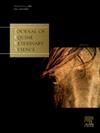解开速度与速度之间的关系:英国草地平地和障碍赛的概念验证研究。
IF 1.3
3区 农林科学
Q2 VETERINARY SCIENCES
引用次数: 0
摘要
赛马在比赛中的最高奔跑速度除其他因素外,还受到地面功能性能("走势")的影响。对于英国的草地赛马场而言,赛马场书记会在比赛当天早上对场地进行描述性分类和数字量化,并随后公布,以协助决策。重要的是,这包括决定一匹马是否应该出赛。赛马分析师也会在赛马会期间使用每场比赛结果中的归一化获胜时间对走势进行评估和分类。赛马走势评估之间的差异经常见诸报端,因此本研究旨在评估另一种衡量赛马走势的方法是否能更好地预测从赛马表现中衡量出的走势。使用线性和非线性回归模型对 25 场平地赛和 25 场障碍赛的测量数据和成绩数据进行了比较。结果发现,连续的两阶段多项式缓冲模型是所有50次比赛中预测成绩的最佳方法(调整后r2=0.819,P<0.05)。本文章由计算机程序翻译,如有差异,请以英文原文为准。
Unravelling the speed-going relationship: A proof of concept study from British turf flat and jump race meetings
The maximum galloping speeds of racehorses during a race are influenced by the functional performance of the ground (‘going’) amongst other factors. For turf racecourses in Britain, the ground is descriptively classified and numerically quantified on the morning of a race meeting by the clerk of the course and subsequently published to assist decision making. Importantly, this includes deciding whether a horse should or should not run. The going is also assessed and classified during the meeting by racing analysts using the normalized winning times from each race result. Differences between going assessments are regularly reported, therefore this study aimed to evaluate whether an alternative method of measuring going could better predict going measured from performances. Measurement and performance data from 25 flat and 25 jump meetings were compared using linear and nonlinear regression models. A continuous two-phase polynomial model for cushioning was found to be the best predictor of performance going for all 50 meetings (adjusted r2=0.819, P<0.001). As cushioning can provide a going related indicator of the forces that the horse will experience at gallop, this measurement may be useful when evaluating racecourse going. This initial model suggests that there is little performance advantage at maximal galloping speeds above a cushioning value of approximately10 kN, possibly due to changes in limb contact timings to manage limb forces limits as the ground becomes firmer. An expansion of objective measurements of going that relate to performance across a wider geographic region, if not internationally are needed to confirm this limit.
求助全文
通过发布文献求助,成功后即可免费获取论文全文。
去求助
来源期刊

Journal of Equine Veterinary Science
农林科学-兽医学
CiteScore
2.70
自引率
7.70%
发文量
249
审稿时长
77 days
期刊介绍:
Journal of Equine Veterinary Science (JEVS) is an international publication designed for the practicing equine veterinarian, equine researcher, and other equine health care specialist. Published monthly, each issue of JEVS includes original research, reviews, case reports, short communications, and clinical techniques from leaders in the equine veterinary field, covering such topics as laminitis, reproduction, infectious disease, parasitology, behavior, podology, internal medicine, surgery and nutrition.
 求助内容:
求助内容: 应助结果提醒方式:
应助结果提醒方式:


